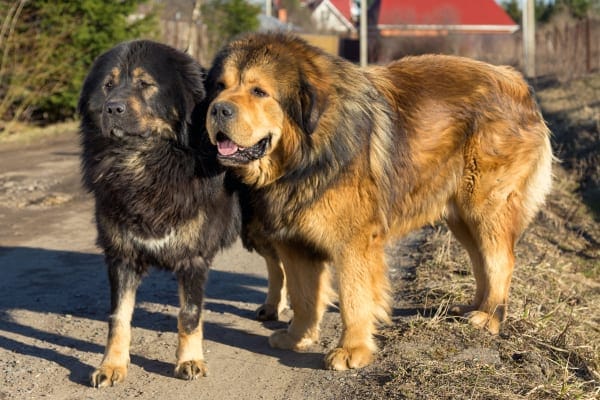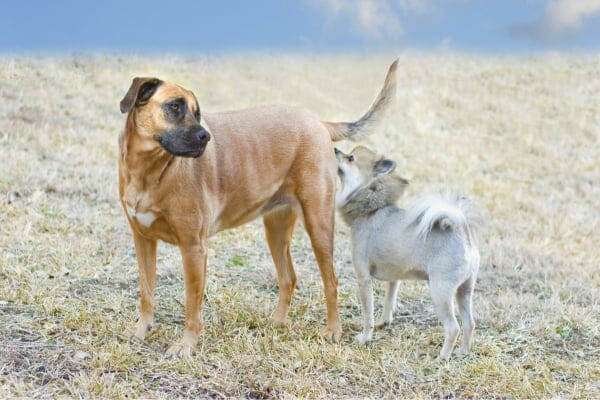
Summary: We all know that dogs are amazing! But how many of these fun facts about dogs do you know? Learn which dog breed has six toes, why dogs have wet noses, and 25 more fun facts about our canine companions.
1. A study at University of California – San Diego claims that your dogs can get jealous when they see you display affection for another creature.
(Is it just me or did we not need a study to recognize this as true?)
2. Puppies have 28 teeth, and normal adult dogs have 42.
(And if you’ve ever raised a puppy, you’ve felt all 28 of them in your flesh.)

3. The Tibetan Mastiff is the oldest dog breed in the world, diverging from grey wolf stock 58,000 years ago.

4. According to Exceptional Canine, the noisiest dog breeds are:
- Chihuahua
- Cairn Terrier
- German Shepherd
- Miniature Schnauzer
- Scottish Terrier
- Rottweiler
- West Highland White Terrier
5. Dogs’ eyes contain a special membrane, called the tapetum lucidum, which allows them to see in the dark.
(This is also the membrane which makes the eyes of a “deer in the headlights” shine blue-green.)
6. The fastest breed, the Greyhound, can run up to 45 miles per hour.

7. Dogs have wet noses because it helps to absorb scent chemicals.
(But as a side note, I consider the cold-wet vs warm nose dog health indicator to be a wives’ tale.)

8. Dogs curl up in a ball when they sleep due to an age-old instinct to keep themselves warm and protect their abdomen and vital organs from predators.

9. A dog’s normal body temperature is between 100 and 102.5 degrees Fahrenheit.
(For more facts about your dog’s temperature, pulse, and respiratory rate, please check out my infographic and podcast: Learn Your Dog’s Normal Vital Signs.)
10. Newborn puppies have heat sensors in their noses to help find their moms while their eyes and ears are closed.

11. The Alaskan Malamute can withstand temperatures that dip to 70 degrees below zero.

12. One un-spayed female dog, her mate and their puppies can produce 67,000 puppies in six years.
13. The Norwegian Lundehund is the only dog with six toes on each foot.

They have six toes on each paw.
(Polydactyly occurs in cats too!)
14. Dogs prefer to relieve themselves with the body being aligned along a North–South axis under calm magnetic field conditions.
(This explains why my dog spins like a compass before squatting!)

15. Dogs are mentioned in the Bible more than 45 times.

16. Female dogs are more likely to greet other dogs by smelling the snout/muzzle first, while males go for the anogenital region.
(You might be able to guess the gender of a dog who greets your dog based on this behavior alone.)

17. It is a myth that dogs can only see in black and white. They can actually see in color, just not as vividly as humans.
18. A typical dog’s mouth exerts 150-200 pounds of pressure per square inch. Some dog breeds can exert up to 743 pounds per square inch (psi).
(This is why chewing hard objects is so dangerous for dogs. They generate so much force that it’s easy to “slab fracture” a piece right off of a major tooth. Check out my approved list of toys and treats in my blog post: Safe Chew Toys for Dogs: “Chews” Wisely.)

19. The U.S. has the highest dog population in the world. Russia the next highest. France ranks third.
(#dogfriendlyusa)
20. Basset Hounds cannot swim.

21. Obesity in dogs is the number one preventable disease in pets.
(For more about determining your dog’s optimal weight, please check out my post, Canine Body Condition Score: Find Your Dog’s Number.)

22. An Australian Cattle Dog named Bluey holds the Guinness world record for the oldest dog ever. He lived for 29 years and 5 months.
(And is an inspiration to us all! Every time I talk to a client about helping their senior dog live long into their golden years, I think of Bluey!)

23. Mongolian ruler Kublai Khan kept 5,000 Mastiffs for hunting and as part of his army.
24. Dogs read human faces and expressions from left to right, which is the same way humans “read” each other’s body language. Dogs don’t do this with any other species, and this may explain why they’re so good at reading our emotions.
25. In the dark, dogs use their whiskers to pick up subtle changes in the air currents. This gives them a better understanding of the environment and helps them “see” better at night.

26. Dogs can sense the earth’s magnetic field. It contributes to their ability to find their way home.
(If you haven’t read The Incredible Journey, I highly recommend it. And, of course, the book is better than the movie.)
27. When dogs howl at each other, they adjust the pitch of the howl to sound unique.

A special “thank you” to Dr. Stephanie Hickey, DVM for compiling these fun and interesting facts about dogs.

Do you know an interesting fact about dogs?
We’d love to hear. Please comment below.


We welcome your comments and questions about senior dog care.
However, if you need medical advice, diagnosis, or treatment, please contact your local veterinarian.